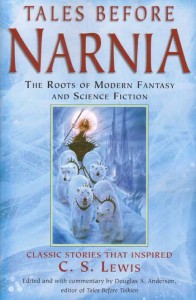
Welcome to Tumnus’s Book Shelf where we review any and all books related to The Chronicles of Narnia and CS Lewis! For today’s book we will be reviewing Tales Before Narnia, edited by Douglas Anderson.
Title: Tales Before Narnia
Author: Various
Edited by: Douglas A. Anderson
Publisher: Del Ray
ISBN -10: 0345498909
ISBN -13: 978-0345498908
Summary:
From Douglas Anderson, editor of Tales Before Tolkien, comes a new book that contains short stories and excerpts of works from authors who influenced Narnia’s creator CS Lewis. From works of the renowned authors like Hans Christian Andersen, Charles Dickens, and JRR Tolkien to the more seemingly obscure like Freidrich de la motte Fouque, Tales Before Narnia is not just a collection of stories compiled in celebration of the land Narnia and her creator, but of classic fantasy literature in general.
Review:
I will make one promise to you in this review. I will not use the word “literary resource,” in describing it. While it certainly is that, to call Tales Before Narnia a resource is to rob this book of it’s beauty and confine it to the halls of the long forsaken literature departments of college campuses where only a handful of students still roam. I will not call it an anthology either, as that can carry connotations of the book being a stuffy, lofty tome, that is accessible only for those who know and care about the subject.
Then what word can I use to describe this book? It’s fun! How else can one describe a collection of twenty enchanting stories? If the Narnian Chronicles are like the big Wardrobe in the Spare Room that can take you to Narnia, this book of tales is like the wood between the worlds that can take you to the other worlds that are connected to Narnia.
Even apart from it’s tie in to Narnia, it is still a wonderfully complied collection of stories. From the notable writers like “JRR Tolkien”, “Charles Dickens”, “Robert Louis Stevenson”, “Kenneth Graham”, “Hans Christian Andersen”, “GK Chesterton“ “ George MacDonald”, “Rudyard Kippling” and “ Henry Wadsworth Longfellow” to the ones whose names are not as revered like “Charles F. Hall”, and “Freidrich de la motte Fouqu”e , each story is equally worthy of being next to each other and can keep a reader entranced.
Certainly, not all the stories that appear in the book seem like Narnia or the things Lewis wrote. They aren’t suppose to. Each story is as unique and original as Lewis’s own work. The main idea of the book is to show what stories inspired Lewis as a writer and fed his own imagination. The styles are all different as are the characters and worlds, but the fantastic elements are what unite the whole volume.
Fantasy stories of other worlds and magical tales of daring do aren’t the only stories that show up in this book. Early “whispers” of Wind in the Willows are also included as well as two often forgotten works that deal with Hell and demons that predate Screwtape’s correspondence with his blundering nephew Wormwood.
The book contains several header notes about the writers, there lives and how they influenced Lewis. Perhaps the most surprising inclusion is an excerpt of fiction by William Lindsay Gresham, Joy Gresham’s ex-husband. Readers will be surprised to find out that Lewis corresponded with him following Joy’s death and had meet him.
I cannot go into great lengths summarizing and analyzing every story in here. Each work, and the writers who wrote them would deserve their own review, as it should be. However, as a whole, Douglas Anderson did a great job not only gathering all these stories but doing his research into the stories to provide footnotes and heading notes. The notes themselves are quick and to the point, and don’t bog down the reading.
The only gripe concerning this book, is that readers are led to believe that these stories had all directly inspired Lewis’s work. This is not the case, and the author even makes it clear that with one story, “Fastosus and Avaro” by John Macgowan, that Lewis was not familiar with the story. However, the main point of the book is not only to show what stories inspired Lewis but to show existing stories with in the genres that Lewis made his impact upon. Overall, this factor is only a minor gripe and does not distract from the book overall.
For those whose appetites have merely been whetted by this book, Anderson provides an index of writers and their works. Only half of the authors listed are actually featured in this book, and it is just as well as if every author included in the index where in the book, it would be the size of a college English text book. It can only make readers hope for a second book of Tales Before Narnia. If no such book surfaces, then at least readers can go to a book store or library and check out those books for themselves. Ater all, what would be a better way to spend a rainy afternoon then at the library brushing up on some great works of speculative fiction?
This book is definitely one book that will have something for every one, whether you are an eight year old fan or an eighty year old fan of Lewis, you are sure to get something out of this book. For those who grew up reading the authors featured in this book, it will be nothing short of a stroll down memory lane with some old forgotten friends and an opportunity to make some new ones. For kids, well, here is one fine set of stories for mom and dad to read to you at bed-time.
Reviewers note: if you enjoy this book, since there is so much overlap between fans of Narnia and Lord of the Rings, fans are encouraged to pick up the companion book Tales Before Tolkien.
Five out of Five
Order the book from http://www.amazon.com/Tales-Before-Narnia-Fantasy-Science/dp/0345498909/ref=pd_bbs_sr_1?ie=UTF8&s=books&qid=1231463851&sr=8-1
